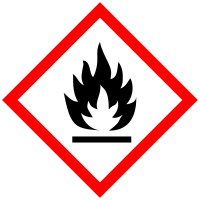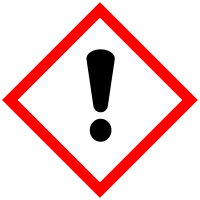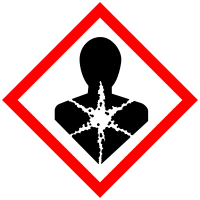
Improving Member States preparedness to face an HNS pollution of the Marine System (HNS-MS)
Propylene Oxide
Description Top
| CAS number | 75-56-9 |
| UN number | 1280 |
| Chemical formula | C3H6O |
| Standard European Behaviour Classification (SEBC) | Dissolver that evaporates (DE) |
GESAMP Hazard profile
| A1 | A2 | B1 | B2 | C1 | C2 | C3 | D1 | D2 | D3 | E1 | E2 | E3 |
| 0 | R | 2 | NI | 1 | 2 | 2 | 2 | 3 | CM | NI | DE | 3 |
Marine pollution Classification (MARPOL Annex II)
| Category | Description |
| Y | Noxious Liquid Substances which, if discharged into the sea from tank cleaning or deballasting operations, are deemed to present a hazard to either marine resources or human health or cause harm to amenities or other legitimate uses of the sea and therefore justify a limitation on the quality and quantity of the discharge into the marine environment. |
Alternate names for this chemical
1,2-Epoxypropane
2-Methyloxirane
Propene Oxide
Epoxypropane
Methyloxirane
Propylene Oxide
Oxyde De Propylene
2-Methyloxirane
Propene Oxide
Epoxypropane
Methyloxirane
Propylene Oxide
Oxyde De Propylene
Physico-chemical properties Top
| Chemical formula | C3H6O |
| Molar mass | 58.079 [g/mol] |
| Critical molar volume | 0.00019 [m³/mol] |
| State | Liquid at 25°C and 1 atm |
Behaviour Top
| Log Kow | 0.03 |
| Log Koc | 0.72 |
| Hydrolysis (Half-life) | 11.6 days |
| Standard European Behaviour Classification (SEBC) | Dissolver that evaporates (DE) |
| Bioconcentration factor (BCF) | 3 |
Ecotoxicity Top
| Lowest median lethal concentration (LC50) on fishes | 52 [mg/l] | |
| Highest no observed effect concentration (NOEC) on fishes | 141 [mg/l] | |
| Assessment factor (AF) |
|
|
| Predicted No Effect Concentration (PNEC) |
|
Hazards Top



Danger
Hazards statements
Physical
H224
Extremely flammable liquid and vapour.
Health
H312
Harmful in contact with skin.
H319
Causes serious eye irritation.
H332
Harmful if inhaled.
H335
May cause respiratory irritation.
H340
May cause genetic defects. Exposure cause the hazard:
H350
May cause cancer.
Precautionary statements
Prevention
P201
Obtain special instructions before use.
P202
Do not handle until all safety precautions have been read and understood.
P210
Keep away from heat/sparks/open flames/hot surfaces. No smoking.
P233
Keep container tightly closed.
P240
Ground/bond container and receiving equipment.
P241
Use explosion-proof electrical/ventilating/lighting/.../equipment.
P242
Use only non-sparking tools.
P243
Take precautionary measures against static discharge.
P273
Avoid release to the environment.
P280
Wear protective gloves/protective clothing/eye protection/face protection.
Disposal
P501
Dispose of contents/container to ...
GESAMP Top
GESAMP Hazard profile
| A1 | A2 | B1 | B2 | C1 | C2 | C3 | D1 | D2 | D3 | E1 | E2 | E3 |
| 0 | R | 2 | NI | 1 | 2 | 2 | 2 | 3 | CM | NI | DE | 3 |
A1: Bioaccumulation
| Rating | Description |
| 0 | No potential to bioaccumulate |
A1a:
| Rating | Description | Criteria [mg/l] |
| 0 | No potential to bioaccumulate | Log Kow < 1 |
A1b:
| Rating | Description |
| NI | No Information |
A2: Biodegradation
| Rating | Description |
| R | Readily biodegradable |
B1: Acute aquatic toxicity
| Rating | Description | Criteria [mg/l] |
| 2 | Slightly toxic | 10 < LC/EC/IC50 ≤ 100 |
B2: Chronic aquatic toxicity
| Rating | Description |
| NI | No Information |
C1: Acute oral toxicity
| Rating | Description | Criteria [mg/Kg] |
| 1 | Slight | 300 < AOTE ≤ 2000 |
C2: Acute dermal toxicity (skin contact)
| Rating | Description | Criteria [mg/Kg] |
| 2 | Moderate | 200 < ADTE ≤ 1000 |
C3: Acute inhalation toxicity
| Rating | Description | Criteria [mg/l] (4 hours exposure) |
| 2 | Moderate | 2 < AITE ≤ 10 |
D1: Skin irritation or corrosion
| Rating | Description | Sign | GHS category |
| 2 | Irritating | Marked erythema, Obvio | Irritant Category 2 |
D2: Eye irritation
| Rating | Description | Sign | GHS category |
| 3 | Severely irritating or corrosive | Severe conjunctoblepha | Irritant Category 1 |
D3: Long-term health effects
| Notation | Hazard endpoint | Description | GHS category |
| C | Carcinogenicity | Chemicals which have been shown to induce or increase the incidence of cancer | Category 1 for Carcinogens |
| M | Mutagenicity | Cause a permanent change in the amount or structure of genetic material in cells | Categories 1 and 2 for Germ Cell Mutagens |
E1: Tainting of seafood
| Rating | Description |
| NI | No Information |
E2: Behaviour of chemicals in the marine environment
| Rating | Description |
| DE | Dissolver that evaporates |
E3: Interference with the use of coastal amenities
| Rating | Interference | Description | Interpretation | Warning |
| 3 | Highly objectionable | 1 is highly acutely toxic; and/or 2 is severely irritant or corrosive to skin or eyes; and/or 3 is carcinogenic, mutagenic or reprotoxic; and/or 4 is a floater or persistent floater with associated health effects | 1 C1 and/or C2 and/or C3 = 4; and/or 2 D1 or D2 = 3, 3A, 3B, or 3C; and/or 3 D3 contains C, M or R; and/or 4 E2 = F or Fp and D3 contains Ss, Sr, T, A, N, or I | Warning issued leading to the closure of amenities |
GHS Security Information



Danger
About the project
HNS-MS is a decision-support tool that Belgian and French maritime authorities as well as coastguard stations can activate in order to forecast the drift, fate and behavior of acute marine pollution by Harmful Noxious Substances (HNS) accidentally released in the marine system.
Contact us
Copyright © 2015–2026 HNS-MS Consortium
 HNS-MS has been funded by DG-ECHO under agreement ECHO/SUB/2014/693705 and runs from 1 January 2015 to 31 March 2017.
HNS-MS has been funded by DG-ECHO under agreement ECHO/SUB/2014/693705 and runs from 1 January 2015 to 31 March 2017.